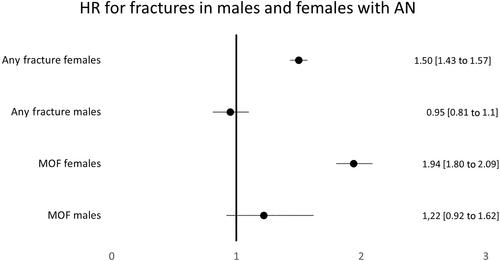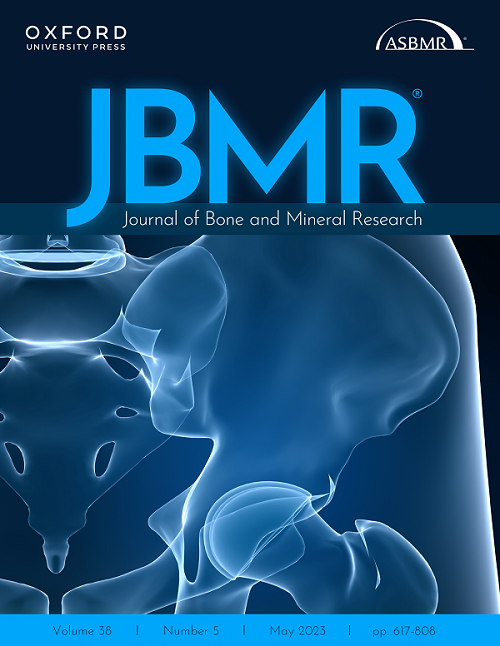下载PDF
{"title":"Fracture Risk in Patients with Anorexia Nervosa Over a 40-Year Period","authors":"Mette Søeby, Sigrid Bjerge Gribsholt, Loa Clausen, Bjørn Richelsen","doi":"10.1002/jbmr.4901","DOIUrl":null,"url":null,"abstract":"<p>Researchers have reported increased fracture risk in patients with anorexia nervosa (AN), but more knowledge on the long-term risk and the effects of age, male sex, and time-related changes is still needed. We examined the long-term (up to 40 years) fracture risk among patients with AN compared to a matched comparison cohort from the general population. We utilized data from the Danish Health Care Registers to identify 14,414 patients with AN (13,474 females and 940 males) diagnosed between 1977 and 2018, with a median age of 18.6 years and median follow-up time of 9.65 years. We calculated adjusted hazard ratios (aHRs) with 95% confidence intervals (CIs) using Cox regression analysis for overall and site-specific fracture risks. The overall aHR of any fracture was 1.46 [95% CI: 1.36 to 1.48], with an aHR of 1.50 [95% CI: 1.43 to 1.57] for females and 0.95 [95% CI: 0.82 to 1.1] for males. For specific fractures we found an association with femur fractures both in females 4.06 [95% CI: 3.39 to 4.46] and in males 2.79 [95% CI: 1.45 to 2.37] and for fractures of the spine (females 2.38 [95% CI: 2.00 to 2.84], males 2.31 [95% CI: 1.20 to 4.42]). The aHR of any fracture decreased from 1.66 [95% CI: 1.52 to 1.81] in the period from 1977 to 1997 to 1.40 [95% CI: 1.33 to 1.40] from 1998 to 2018. In conclusion, we found that AN was associated with a 46% increased risk of any fracture up to 40 years after diagnosis. We found no overall increased risk in males, but in both sexes we found a particularly high site-specific fracture risk in the spine and femur. Fracture risk decreased in recent decades, indicating that more patients with AN have been diagnosed with presumably less severe disease and that the earlier detection and intervention of AN in recent years may translate into a lower facture risk. © 2023 The Authors. <i>Journal of Bone and Mineral Research</i> published by Wiley Periodicals LLC on behalf of American Society for Bone and Mineral Research (ASBMR).</p>","PeriodicalId":185,"journal":{"name":"Journal of Bone and Mineral Research","volume":"38 11","pages":"1586-1593"},"PeriodicalIF":5.1000,"publicationDate":"2023-08-14","publicationTypes":"Journal Article","fieldsOfStudy":null,"isOpenAccess":false,"openAccessPdf":"https://asbmr.onlinelibrary.wiley.com/doi/epdf/10.1002/jbmr.4901","citationCount":"0","resultStr":null,"platform":"Semanticscholar","paperid":null,"PeriodicalName":"Journal of Bone and Mineral Research","FirstCategoryId":"3","ListUrlMain":"https://onlinelibrary.wiley.com/doi/10.1002/jbmr.4901","RegionNum":1,"RegionCategory":"医学","ArticlePicture":[],"TitleCN":null,"AbstractTextCN":null,"PMCID":null,"EPubDate":"","PubModel":"","JCR":"Q1","JCRName":"ENDOCRINOLOGY & METABOLISM","Score":null,"Total":0}
引用次数: 0
引用
批量引用
Abstract
Researchers have reported increased fracture risk in patients with anorexia nervosa (AN), but more knowledge on the long-term risk and the effects of age, male sex, and time-related changes is still needed. We examined the long-term (up to 40 years) fracture risk among patients with AN compared to a matched comparison cohort from the general population. We utilized data from the Danish Health Care Registers to identify 14,414 patients with AN (13,474 females and 940 males) diagnosed between 1977 and 2018, with a median age of 18.6 years and median follow-up time of 9.65 years. We calculated adjusted hazard ratios (aHRs) with 95% confidence intervals (CIs) using Cox regression analysis for overall and site-specific fracture risks. The overall aHR of any fracture was 1.46 [95% CI: 1.36 to 1.48], with an aHR of 1.50 [95% CI: 1.43 to 1.57] for females and 0.95 [95% CI: 0.82 to 1.1] for males. For specific fractures we found an association with femur fractures both in females 4.06 [95% CI: 3.39 to 4.46] and in males 2.79 [95% CI: 1.45 to 2.37] and for fractures of the spine (females 2.38 [95% CI: 2.00 to 2.84], males 2.31 [95% CI: 1.20 to 4.42]). The aHR of any fracture decreased from 1.66 [95% CI: 1.52 to 1.81] in the period from 1977 to 1997 to 1.40 [95% CI: 1.33 to 1.40] from 1998 to 2018. In conclusion, we found that AN was associated with a 46% increased risk of any fracture up to 40 years after diagnosis. We found no overall increased risk in males, but in both sexes we found a particularly high site-specific fracture risk in the spine and femur. Fracture risk decreased in recent decades, indicating that more patients with AN have been diagnosed with presumably less severe disease and that the earlier detection and intervention of AN in recent years may translate into a lower facture risk. © 2023 The Authors. Journal of Bone and Mineral Research published by Wiley Periodicals LLC on behalf of American Society for Bone and Mineral Research (ASBMR).
40年间神经性厌食症患者骨折风险分析
研究人员已经报道神经性厌食症(AN)患者骨折风险增加,但仍需要更多关于长期风险和年龄、男性性别和时间相关变化的影响的知识。我们检查了AN患者的长期(长达40年)骨折风险,并与来自普通人群的匹配对照队列进行了比较。我们利用丹麦卫生保健登记册的数据,确定了1977年至2018年间诊断出的14,414名AN患者(13,474名女性和940名男性),中位年龄为18.6岁,中位随访时间为9.65年。我们使用Cox回归分析计算了整体和部位特定骨折风险的校正风险比(aHRs), 95%置信区间(CIs)。任何骨折的总aHR为1.46 [95% CI: 1.36至1.48],女性aHR为1.50 [95% CI: 1.43至1.57],男性aHR为0.95 [95% CI: 0.82至1.1]。对于特定骨折,我们发现与股骨骨折的相关性,女性为4.06 [95% CI: 3.39至4.46],男性为2.79 [95% CI: 1.45至2.37],脊柱骨折为2.38 [95% CI: 2.00至2.84],男性为2.31 [95% CI: 1.20至4.42])。任何骨折的aHR从1977年至1997年的1.66 [95% CI: 1.52至1.81]下降到1998年至2018年的1.40 [95% CI: 1.33至1.40]。总之,我们发现AN与诊断后40年内任何骨折风险增加46%相关。我们没有发现男性总体风险增加,但在两性中,我们发现脊柱和股骨的特定部位骨折风险特别高。近几十年来,骨折风险下降,这表明更多的AN患者被诊断为可能不太严重的疾病,近年来早期发现和干预AN可能转化为更低的骨折风险。©2023作者。由Wiley期刊有限责任公司代表美国骨与矿物研究协会(ASBMR)出版的骨与矿物研究杂志。
本文章由计算机程序翻译,如有差异,请以英文原文为准。



